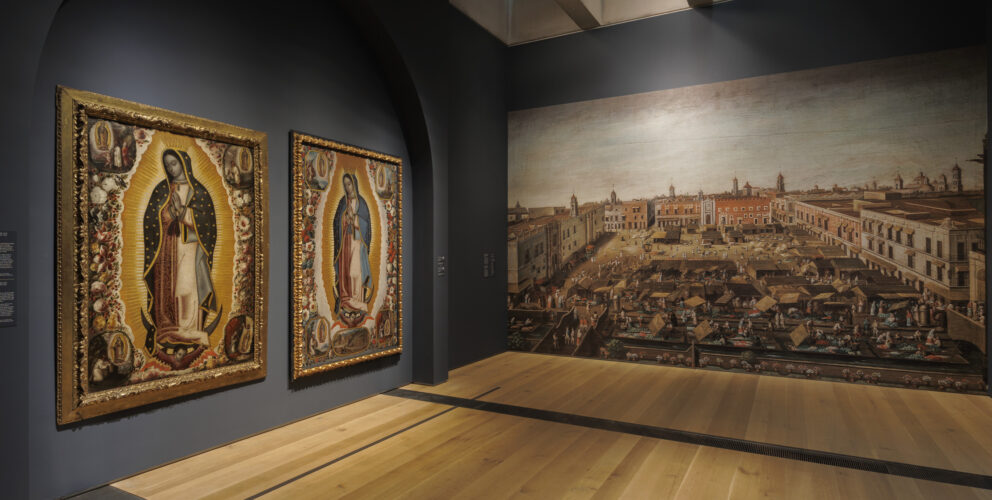Melchor Pérez Holguín, Bolivia; Pietà (Piedad), circa 1720; oil on canvas: 60 1/4 × 48 7/8 inches; Los Angeles County Museum of Art, Purchased with funds provided by the Bernard and Edith Lewin Collection of Mexican Art Deaccession Fund 2024.115; photo © Museum Associates/LACMA
Melchor Pérez Holguín (c.1660–c.1732) was regarded as one of the most important painters in the thriving silver mining town of Potosí, in present day Bolivia. The history and culture of Potosí, where Holguín lived most of his life, provides an important context for his Pietà, which can be seen in Art and Imagination in Spanish America, 1500–1800: Highlights from LACMA’s Collection, on view at the Saint Louis Art Museum through September 1.

Melchor Pérez Holguín, Bolivia; Pietà (Piedad), circa 1720; oil on canvas: 60 1/4 × 48 7/8 inches; Los Angeles County Museum of Art, Purchased with funds provided by the Bernard and Edith Lewin Collection of Mexican Art Deaccession Fund 2024.115; photo © Museum Associates/LACMA
A pietà is an image that depicts the Virgin Mary cradling the body of the deceased Christ. In Holguín’s deeply moving pietà, a gaunt and bloody Christ lies on Mary’s lap, surrounded by angelic figures lamenting his gruesome fate. The artist created this work around 1720, while living and working in Potosí.
During Holguín’s lifetime, Potosí was renowned for its abundance of native metal. The mountain at the center of the city, named Cerro Rico (rich hill), was a mineral deposit that would go on to provide over half of the world’s silver for almost three centuries. This mining town, unique for its geology, drew merchants from across the globe. Spain’s exploitation of the resources in Potosí after 1545 increased the empire’s wealth and reach exponentially. Soon after, Spain founded the Imperial Villa of Potosí, where Holguín would go on to live by 1678. In the 1600s and 1700s, several epidemics tore through Potosí, leading many of its citizens to lean on devout Catholicism for solace, including Holguín.

By Mhwater at Dutch Wikipedia - Eigen foto
Themes inspired by Potosí’s immense riches and its religious culture are apparent in Holguín’s Pietà. Gold leaf adorns the Virgin Mary’s cloak, reminding the viewer of Potosí’s striking wealth at the time. Ilona Katzew, exhibition curator and department head of Latin American art at LACMA, which organized the exhibition, described the use of gold leaf ornamentation as a response to the silver city’s “growing local taste for richly decorated surfaces,” in the exhibition’s catalogue. Additionally, the regularity of marrying splendor with religion in colonial Andean life is detailed in a catalogue entry by scholar and curator Elena Phipps. This is demonstrated in paintings of Christian icons, ornate with gold and silver, and in shimmering religious processions that featured participants in their best dress, wearing “gold, silver, pearls, and jewels . . . as they paraded two by two along the streets of the city.”
While much of the gold ornamentation is cracked with age, some of it varies in style, suggesting it was added later in the life of the painting. The hood of the gilded cloak frames the Virgin Mary’s pained expression. According to a video by the Los Angeles County Museum of Art: “Holguín’s distorted and highly expressive figures endowed his images with a sense of pathos that appealed to local forms of religiosity.” As seen in his depiction of the Virgin Mary, this expressiveness can be seen in the artist’s anguished depiction of Christ and the distraught angels surrounding him.
Red and green are consistent throughout the work. In precolonial Andean culture, these colors were associated with the sacred. By transposing these colors to Christian iconography, artists may have “triggered a type of energy that kept ancient ideas of the sacred alive,” according to LACMA.
This information was adapted from essays in the Los Angeles County Museum of Art exhibition catalogue Archive of the World: Art and Imagination in Spanish America, 1500–1800 written by Ilona Katzew, exhibition curator and department head of Latin American art at LACMA. The catalogue is available for purchase online or in the Museum Shops.
